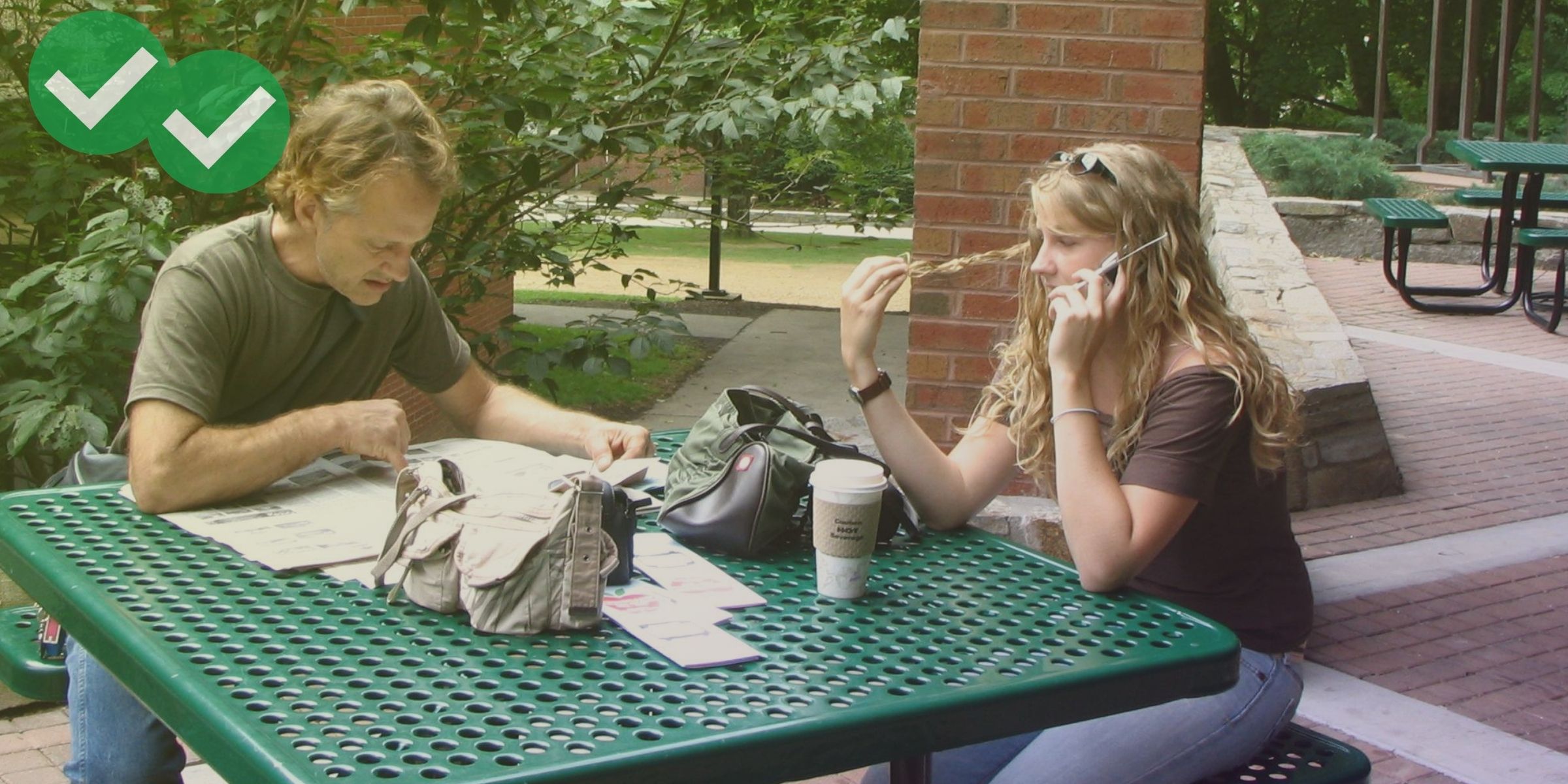Before learning about the various TOEFL Speaking topics, make sure that you understand the basics of the TOEFL iBT Speaking section. Our TOEFL Speaking infographic is a great place to start:

Now, on to the specifics …
What You’ll Learn in This Post
You’re probably here because you want to understand what concepts the Independent portion of the TOEFL Speaking section tests, how it tests those concepts, and what types of questions you can expect to see on test day. And that’s exactly what you’ll find! The goal of this post is to introduce you to TOEFL Speaking on a high level and then delve into specifics that will help you prepare for TOEFL Speaking Task 1 as a test taker, making the most of your preparation time.
In this post, we’ll take a close look at TOEFL Speaking Task 1. When you finish (or if you’re already comfortable with Task 1), check out Magoosh’s posts on the other TOEFL tasks:
Table of Contents
Here are the sections in case you’d like to jump ahead:
- The Difference Between the Two Types of Speaking Tasks
- TOEFL Speaking Task 1
- Approaching TOEFL Independent Tasks
- Tips for TOEFL Task 1 Speaking Topics
- Using a Template for Task 1: MEEM
- Using a Template for Task 1: SEA
- TOEFL Speaking Task 1 with Answer Samples
- Sample TOEFL Speaking Practice Topics for Task 1
- How to Prepare for the TOEFL Speaking Test
- TOEFL Task 1: Mock Test
- Final Thoughts on TOEFL Speaking Task 1
The Difference Between Integrated and Independent TOEFL Speaking Tasks
Similar to the TOEFL Writing section, the TOEFL Speaking section includes two types of tasks—“Independent” questions and “Integrated” questions. In terms of topics, there’s a pretty clear divide between the two types you’ll see in the speaking section of the TOEFL exam: Integrated tasks are about academic topics while Independent speaking topics are about personal experiences, opinions, and ideas.
The “Integrated” topics on the TOEFL test are called that for a reason: they integrate a short passage of reading and/or listening passage with speaking. That also means that Integrated Speaking topics are as varied as Listening and Reading topics, and answering them well mostly depends on how well you can find the most important ideas in an audio recording or reading passage. Note that while these are on an academic subject, they don’t require specialized knowledge to answer them.
In contrast, the Independent tasks are a different type of question. They are on a familiar topic and are only really about how well you can speak, rather than how well you digest incoming information. That means communicating your personal preference clearly.
TOEFL Speaking Task 1: Choose a Preference from Two
This Speaking prompt is the only Independent Speaking prompt currently on the TOEFL. Older TOEFL prep resources will mention two Independent Speaking tasks, so if you’re using older prep, note that the prior version of the TOEFL had two Independent Speaking topics. Also, note that Task 2 in the old TOEFL is the same thing as Task 1 in the current test.
Task 1 will be very similar to many TOEFL essay prompts. It will ask you to make a choice between two things, then support that choice.
EXAMPLE: Some people prefer work that allows them to move around outdoors. Others feel it is more pleasant to work in an office. Which do you prefer, and why?
Note: ETS used to give a list of essay prompts for free on their website, but they deleted that page. Now, you need the Official Guide to the TOEFL, fourth edition see the list of essay prompts mentioned above. (Sadly, the list in the fifth edition of the TOEFL Official Guide is much shorter, although that current edition does contain several new prompts not seen in the Fourth edition.)
Again, this is an exercise in choosing fast. You only have 45 seconds to answer, so you need to make a quick decision and then work on supporting it with a reason or two. You can also use examples to make your point–but remember, the time frame is very short!
Cats or dogs?
Black or white?
Cold or hot?
And then there’s the most important part of the question: why?
ETS, which makes both the TOEFL and the GRE, likes to ask questions about education especially. So, in order to prepare for your TOEFL, it’s a good idea to practice speaking about your preferences in education. Focus not just on your language use and effective use of grammar, but also on producing ideas quickly in response to the prompts. Where do you like to study? What types of teachers do you like? Do you like to work alone or in groups? What subjects are the most interesting? (If you’re going to take the GRE, that essay is very possibly going to be about education, too, so this might help in that preparation as well.)
It’s okay if you don’t have a strong opinion on these topics. For the test, you can pretend that you do! Meanwhile, If you’re wondering what sample answers for these tasks look like, check out Magoosh’s Speaking PDF with sample questions, good examples of answers, and explanations for each prompt!
Approaching TOEFL Independent Tasks
At a glance, the TOEFL Independent Speaking Task seems like the easiest part of the Speaking section. You don’t have to do any reading, listening, or note-taking, and you only have to speak for 45 seconds. That’s less than a minute!
However, there is a way in which the shorter timing for the Independent Speaking Task can work against you. The preparation time is also very short—you have just 15 seconds to think of an answer. Because of this, many test-takers find that they don’t have enough to say, even in the short 45 second time they’re given to talk. They simply weren’t able to think of an answer quickly enough.
Ultimately, Speaking Task 1 is the most fast-paced question in the whole TOEFL Speaking section. This question seems personal, but there’s really no time for self-reflection, and you don’t have time to really reflect on your opinions.
The Independent task is not really an assessment of your life and opinions. It’s an assessment of your ability to think quickly and promptly express your thoughts in English. As you rush to think up a good response in just 15 seconds, there are a few things you should remember.
For one thing, you should be prepared to use the very first idea or opinion that pops into your head. You can’t afford to waste time trying to think of the perfect idea or response. Just pick your response quickly and run with it.
You also need to remember that it’s perfectly OK to just make something up. You may find that you’re not sure of your opinion, or you do have an opinion, but you can’t immediately think of how to express it. That’s OK. You can just go with the side of the argument or issue that seems easiest to defend. You can do this even if it’s not the side you truly agree with. As I’ve said before, it’s OK to lie on the TOEFL.
Above all, the best way to get faster and better at Speaking Task 1 is to practice, practice, practice. And sometimes the practice questions on Magoosh and in the ETS official materials just aren’t enough. Sometimes you need to just run through dozens of Independent Speaking questions. That way, you can get a better feel for the kinds of things you’ll be asked. And you can have plenty of rapid-fire practice at increasing your speed and thinking up answers in 15 seconds or less.
Fortunately, there are a number of websites with long lists of Independent Speaking questions. For example, I recommend this list.
To briefly summarize your quick-thinking skills for this task: run with the first thought you have, lie if you must, and practice as many of these kinds of questions as you can. This will help you quickly think up enough ideas to fill 45 seconds of speech. You’ll be rushing toward a good TOEFL Independent Speaking score faster than you think.
Tips for TOEFL Task 1 Speaking Topics
Go With Your First Instinct
For Independent topics, the important part of these questions is to think of an answer that’s easy to give and defend. To see how this process for choosing a simple answer works, let’s look at this TOEFL Speaking Task 1 question:
- Some people think it is very important to have social interactions with neighbors. Others feel it is not important for neighbors to know each other. Which do you agree with, and why?
When faced with an Independent Speaking question like this, it can be tempting to answer the question in the same way that you would in a conversation: by saying exactly what you really feel. But on this TOEFL task, you have a limited amount of time. So it can be better to give a simpler version of your opinion on the given topic. And, as I mentioned above, it may even be best to state an opinion you don’t actually hold if that opinion is the easiest one for you to explain.
Using the example above, I actually believe that interacting with your neighbors isn’t so important. But when I tried to think of why I feel that way, I realized the reasons are personal and complicated. Knowing my neighbors isn’t a priority for me because most of my friends and family live outside my neighborhood. It also isn’t a priority for me because I spend a lot of time socializing with my students and colleagues, and don’t have much time left over to get to know people who live in my immediate area.
Turning my personal situation into a well-supported position on a social issue seems hard to me. I don’t know if I can do that in just 45 seconds. So instead, on this response, I’ll say that interacting with neighbors is important because it makes your neighborhood a strong, safe community. This isn’t the real side I take on this issue. But for me, it’s the simplest side I can take on the issue.
So be open to expressing an opinion other than your real one. Sometimes the side of the issue that you don’t agree with can be explained more simply.
Keep your statement-of-opinion short and support your opinion with just one or two points
Your opinion, as stated, should ideally be one sentence long (or possibly two short sentences). In my response, I’ll choose to side in favor of talking to the neighbors. And I’ll state my position as simply as I can:
- I believe that interacting with your neighbors is important because it turns your neighborhood into a strong, safe community.
Once you’ve made a simple statement-of-opinion on the Speaking Task 1 issue, you’ll want to support the opinion very simply as well. To stay in that 45 second time limit, support your Task 1 opinion with just one or two details. And express those supporting details in 4 or 5 sentences. A simple set of supporting details for my opinion above might look like this:
- When neighbors know each other’s needs and struggles, they can help each other. For example, if you know that your neighbor’s car is broken down, you can drive your neighbor to work until the car is fixed. And a neighborhood where people interact a lot is safer too. When a neighbor is in danger, neighbors who talk are more likely to notice the danger and react to it. If you visit your neighbors regularly, you will notice if they injure themselves and can’t come to the door, or if their kitchen is on fire.
The opinion statement and topic development above might just be enough to fill 40-45 seconds of audio. So you may have a complete response right here. Or you might not, depending on the pace of your speech. When I read this response out loud to myself, I finished talking in 38 seconds. That’s a little short. To fill out the time, I’ll need to add one more sentence at the end of my answer. This brings me to my next tip for the TOEFL Independent Speaking Task…
If possible, address the other side of the issue (but avoid a counter-argument)
If you still have some time left after stating your opinion and giving some supporting evidence, it’s a good idea to talk briefly about the other side of the issue. Addressing the other side of the issue makes your answer seem thoughtful and truly complete. But remember, keep it simple. The trick here is to acknowledge the other side of the issue without going into a complicated counter-argument.
A counter-argument is an argument in favor of a belief that is the opposite of your stated opinion. It’s used to address objections a person might have if they disagree with your opinion on an issue. Counter-arguments are not bad per se — they are a great way to fully explore an issue in a long speech. But in your 45 second TOEFL Speaking Task 1 speech, there really isn’t time to develop a counter-argument.
Instead, you can end a TOEFL Speaking Task 1 response by very briefly explaining why the other side of the argument isn’t a good one. Do keep it brief, though: arguing for both sides of the issue would make my response too long and complicated. I wouldn’t be able to give a full answer in the 45-second time limit for the task.
Using a Template for Task 1: MEEM
There are many different ways to get a high score on TOEFL Speaking Task 1. However, using a template can help you get more comfortable providing specific examples for this question type. (You can check out templates for all TOEFL Speaking tasks here!)
With that in mind, let’s look at a template I like to call the MEEM template. MEEM stands for: Main idea, Examples and Explanations, Main Idea again.
The MEEM pattern for TOEFL Speaking Task 1 responses is a little bit like the pattern for the five-paragraph essay. Like the five-paragraph essay, this structure for a Speaking response talks about the main idea in its introduction, then expands on the main idea after the introduction, and finally reviews the main idea in a concluding statement.
Unlike the five-paragraph essay, a MEEM response to TOEFL Speaking Task 1 won’t necessarily have paragraph-length introductions and conclusions. You only have 45 seconds to speak, so think of this template as a simplified, spoken version of a five-paragraph essay… or as a simplified spoken version of TOEFL Writing Task 2.
Transcript of an Example MEEM Speaking Task
Now we’ll look at how MEEM can work in an actual response. The response will be to this example TOEFL Speaking Task 1 question:
- Do you agree or disagree with the following statement? Use details and examples to explain your argument.
It is very important for the government to fund the arts.
Now, here’s a response, with each part of the MEEM template labeled:
- MAIN IDEA: Although I don’t think government funding for the arts is bad, I also don’t think it’s as important as other government funds.
- EXPLANATIONS AND EXAMPLES: Art is enjoyable, and having well-funded arts is wonderful, but not always practical. The first job of the government is to provide public services, and the second job of the government is to help people in need. Art comes after these priorities. For example, the government shouldn’t pay any money to the arts if it can’t maintain good roads and schools, or it lacks the funding to help families out of poverty.
- MAIN IDEA, RESTATED: So for these reasons, I think art funding should never be treated as an important priority. Too many other government projects are more important.
MEEM isn’t the only template you can use to get a high score on this task, though! Let’s take a look at another way of approaching the TOEFL Speaking Task 1.
Using a Template for Task 1: SEA
An alternative to MEEM is SEA. This is a three-step template you can use to guide your Task 1 answers. To keep your answer straight and to the point, it helps to say which side you are taking right away. So that’s the first step of the template: take a side.
After you take a side, you need to explain why your side is right. This brings us to the next step: explaining your position on the social issue. In other words, use reasons to support your point.
Finally, at the end, you should talk about the alternative to your position, if possible. Addressing the other side of the issue makes your explanation of your side seem very complete and well-thought-out. Because you only have 45 seconds to talk, you may or may not have time for this final third part of the template. But it is a great way to conclude your TOEFL Speaking Task 2 response if there’s enough time.
To memorize this three-step template, think of it as the “SEA template.” First you take a SIDE on the issue. Then you EXPLAIN your side. Finally (time allowing), you discuss the ALTERNATIVE to your position. Side. Explanation. Alternative. SEA!
Now, let’s use this template to answer an example TOEFL Speaking Task 1 question. Here’s the question:
- Some schools provide children with health education classes. Other schools send health information to parents so that parents can teach their own children about health issues. Which approach do you think is better, and why?
On this question, I’ll take the side of teaching health education in school. My explanation of my position will focus on the health expertise a trained teacher has. And the alternative to my position is — as stated in the question — parents teaching health to their kids. Here is a SEA template, with my answer:
- SIDE: I believe that health education should be taught to children in school.
- EXPLANATION: Health teachers have special training and expertise in health. A good teacher can tell kids everything they need to know about health. And health teachers will know how to answer any questions that their students have about healthy living. With this information, kids can keep themselves healthy.
- ALTERNATIVE: If health education is just done by parents, kids may not get correct, expert health advice. Most parents aren’t health experts, and some parents might not even have the time to give their kids any health tips at all. So without regular health classes, kids could be misinformed about health, and might make unhealthy choices that are bad for them.
TOEFL Speaking Task 1 with Answer Samples
With those templates in mind, take a look at a sample set for a Task 1 prompt. Give yourself 15 seconds to prepare, then 45 seconds to answer. After you’ve answered, check out the sample response to see what a high-scoring answer for this task looks like, then read on for an explanation as to why it would receive a high score.
Question
Often, people prepare their food at home and bring it to work or school. Buying food on one’s lunch break is also a popular practice. Which lunch break practice is your favorite? Give supporting details and reasons.
Sample Response
“Personally, I prefer to bring my own food to my job or to school. If I buy food while I’m out of the house, I often buy something that is unhealthy. For example, I might buy candy bars from the vending machine, because I feel too busy to go to the cafeteria or a restaurant. But even cafeteria and restaurant food are sometimes not-so-healthy. I can only control how healthy my food is if I bring it myself.
Also, I like to have as much time as possible to relax and to eat when I have a break from school or my job. I don’t want to take extra time to find food and wait in line to buy it. That time’s better spent enjoying the food I brought from home, and chatting with colleagues.
Although buying food at work or school seems convenient, it has a higher cost. And I don’t just mean money. Getting food at school or work also takes up precious break time too. And it can be bad for your health… Bringing food from home really is better.”
Explanation
If you don’t want to use a specific template, this general format is a great one to use on the test: “I prefer/believe that…”, then some examples, then an “although statement,” followed by a concluding remark. Remember that any well-developed answer is correct, and any poorly-developed answer is wrong. You will not lose points for picking an opinion that the graders don’t agree with.
Notice, however, that this test-taker does everything that the templates do, just in her own way. She uses specific reasons to create a strong argument. The speaker’s opinion is clear from the beginning of the response.
If you want more practice with this kind of Speaking question, read on!
Sample TOEFL Speaking Practice Topics for Task 1
1. Some people prefer work that allows them to move around outdoors. Others feel it is more pleasant to work in an office. Which do you prefer, and why?
2. Do you agree or disagree with the following statement? Use details and examples to explain your answer.
Snakes should never be kept as pets.
3. Some people feel they perform better when they have to finish by a strict time. Others feel they do better work if they do not have time pressure. Which best describes you? Explain why.
4. Do you agree or disagree with the following statement? Use details and examples to explain your answer.
Parents should buy for their children any books that the children choose to read.
5. Do you agree or disagree with the following statement? Use details and examples to explain your answer.
Students should spend more time learning outside of classrooms than within classrooms.
6. In some areas, summer days are longer, so there is more daylight in the evening and early morning, but winter days are shorter. In other areas, summer and winter days are similar lengths throughout the year. Which do you prefer, and why?
7. Do you agree or disagree with the following statement? Use details and examples to explain your answer.
Movies that are longer than three hours should be made shorter by removing less important scenes.
8. Do you agree or disagree with the following statement? Use details and examples to explain your answer.
Parents who do not regularly exercise should start in order to be good role models for their children.
9. Some people prefer to respond to emails, phone calls, and other messages they receive immediately. Others take more time to respond. Which do you do, and why?
10. Do you agree or disagree with the following statement? Use details and examples to explain your answer.
It’s better to reward employees with gifts and job perks, such as gym memberships or English classes, than it is to simply pay more.
How to Prepare for the TOEFL Speaking Test
Within the first task, TOEFL Independent Speaking subjects have a very wide range. If you also factor in the Integrated, academic tasks, that range is enormous. The most important thing for preparing isn’t learning all of the topics; it’s learning how to answer completely in a very short time and under pressure, and knowing the proper strategies to tackle each task. A great way to do this is by taking a TOEFL practice test and signing up for the free trial of our premium prep. But you can also check out our free complete guide to TOEFL Speaking right here on the blog.
You might also download our free TOEFL Speaking app for your iPhone or Android. The app simulates the real TOEFL Speaking test with free practice Speaking materials. You can even use it in offline mode at any time you need more practice.
TOEFL Task 1: Mock Test
If you’re ready to take your TOEFL practice to the next level, try this free sample Task 1 prompt from the Magoosh TOEFL’s premium prep service. Complete this sample Task 1 prompt:
Many people prefer watching music videos on television or the Internet rather than listening to the songs on their own. Which way of experiencing music do you think is preferable and why?
- Preparation time: 15 seconds
- Response time: 45 seconds
You can use a timer on your phone or an online timer (such as Google timer) to hold yourself to the time limits. And you can use your computer’s microphone or a web app such as Online Voice Recorder to record and save your response.
Then, when you’re done, check the video answer and explanation to see how you did.
Takeaways
Mastering the TOEFL Speaking Task 1 is important for many reasons–after all, it’s the first task you’ll see in this section, and doing well on it will give you confidence as you go through the rest of the TOEFL Speaking topics! While it can feel unusual to discuss your personal opinions in such a short amount of time, practicing (particularly with high-quality questions and templates) will give you the experience you need to ace this task on test day. Finally, be sure to sign up for Magoosh’s 1 Week Free Trial to get access to some Speaking lesson videos from our TOEFL Experts. Good luck!






Leave a Reply